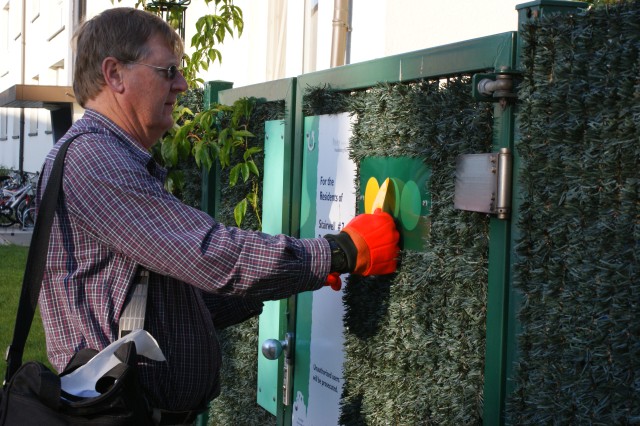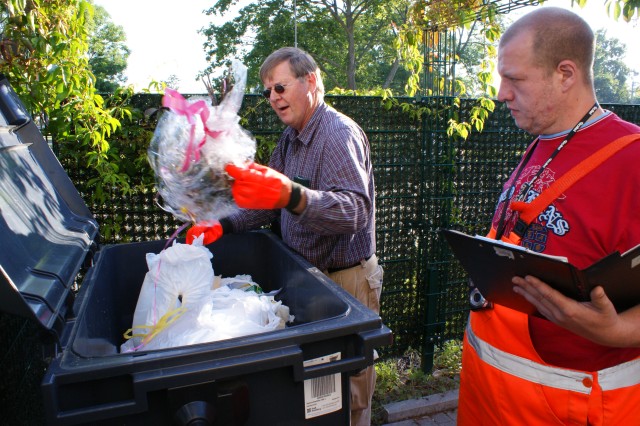HEIDELBERG, Germany -- Forty-one stairwells on Patrick Henry Village in Heidelberg are about to take the recycling plunge as they enter Phase III of Rumbling Rubbish, a program designed to educate residents, reduce waste, and save government money.
For the last four weeks, Marty Hanson and Markus Ecker have been dumpster diving across PHV in the early morning hours to establish a baseline report on how the 41 stairwells are performing in their recycling efforts.
"We want to see how things are going," said Hanson, Pollution Prevention Program manager with the U.S. Army Garrison Heidelberg Directorate of Public Works.
What comes next is a 15-week program of enforcing the standard when it comes to waste management through a feedback program - which consists of a green, yellow and red dot system at each recycling island - while providing assistance and education to the residents as needed.
If a stairwell falls below the standard - and receives a yellow dot - for more than three weeks in a row, the stairwell receives a red dot, and the garrison commander is notified.
"When I'm informed about a stairwell receiving a red dot, the first action I take is to ask our folks what they have done to help," said Lt. Col. Robert White, USAG Heidelberg commander. "When face-to-face training and assistance has been rendered, but the stairwell continues to receive red dots, then I send a personal invite to the stairwell and building coordinators to come see me to determine how we can bring that stairwell into compliance with host nation law."
If the situation becomes a safety or health risk, White said he'll involve the Soldiers' chain of command, and if necessary, bring in health specialists and social services to remedy the problem. In a worst-case scenario, White said he can invoke UCMJ action. That said, White added that the community has really gotten into the program.
"I believe everyone wants to do their part," he said. "They just want to know how, so the educational portion of this program is the real key to our success, not the threat of enforcement action."
At the end of the 15 weeks, the city replaces the 1,100 liter restmAfA1/4ll (grey) containers with a 660-liter container. The switch saves the garrison about Ac'A!1,000 per year, per stairwell.
The program has gone through a pilot and two other phases, bringing a total of 152 stairwells on board, including all of the Mark Twain Village buildings as well as many of the stairwell buildings on PHV.
To ensure the residents in the initial phase keep up the good work and to encourage residents new to the community, Hanson and Ecker, a sanitation worker with the city of Heidelberg, spot check 25 recycling islands each week and keep coming back if a stairwell is not meeting the standard.
The two look to see that the paper (blue) and packaging (yellow) containers are full, while the restmAfA1/4ll (grey) container is less than half full, and the compost container (brown) is at least being used.
To help with the compost program, the city of Heidelberg donated in-home composting bins for each of the apartments participating in phase III.
"It's an indication of how the city is backing us in this program," Hanson said.
During a baseline inspection June 18, however, Hanson found one of the donated containers in a yellow bin. Ecker took pictures to show the building coordinator for possible action.
Whenever a stairwell doesn't meet the standard, Ecker takes pictures of the containers and the overall appearance of the recycling island to document their finding and to provide proof the building coordinators and, if necessary, the garrison commander.
"We get a hold of the stairwell and building coordinators to keep them from going red," Hanson said. "We do all we can to keep them from going to Lt. Col. White."
The key to the whole program, and recycling in general, according to Hanson, is being set up in the home to separate the waste, then when you take the separate containers to the recycling island, there's little chance of putting waste in the wrong containers.
"Rumbling Rubbish has really opened the eyes of many as to how much of what we throw away can be reused or recycled," White said. "The net amount of rubbish we as a community dispose of is steadily decreasing in real terms - amount per capita - while the amount we recycle is constantly increasing."
(Editor's Note: Jason Austin writes for the USAG Baden-WAfA1/4rttemberg newspaper, the Herald Post.)




Social Sharing